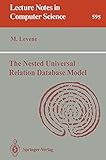The Nested Universal Relation Database Model [electronic resource] / edited by M. Levene.
Material type: TextSeries: Lecture Notes in Computer Science ; 595Publisher: Berlin, Heidelberg : Springer Berlin Heidelberg, 1992Description: X, 182 p. online resourceContent type: text Media type: computer Carrier type: online resourceISBN: 9783540471103Subject(s): Computer science | Software engineering | Database management | Computer Science | Database Management | Computation by Abstract Devices | Software EngineeringAdditional physical formats: Printed edition:: No titleDDC classification: 005.74 LOC classification: QA76.9.D3Online resources: Click here to access online
TextSeries: Lecture Notes in Computer Science ; 595Publisher: Berlin, Heidelberg : Springer Berlin Heidelberg, 1992Description: X, 182 p. online resourceContent type: text Media type: computer Carrier type: online resourceISBN: 9783540471103Subject(s): Computer science | Software engineering | Database management | Computer Science | Database Management | Computation by Abstract Devices | Software EngineeringAdditional physical formats: Printed edition:: No titleDDC classification: 005.74 LOC classification: QA76.9.D3Online resources: Click here to access online  E-BOOKS
E-BOOKS
| Current library | Home library | Call number | Materials specified | URL | Status | Date due | Barcode |
|---|---|---|---|---|---|---|---|
| IMSc Library | IMSc Library | Link to resource | Available | EBK5981 |
The underlying database models -- The null extended nested relational model -- Null extended data dependencies and the extended chase -- A universal relation model for a nested database -- A universal relation model for a single nested relation -- Concluding remarks and ongoing research.
This monograph describes a method of data modelling whose basic aim is to make databases easier to use by providing them with logical data independence. To achieve this, the nested UR (universal relation) model is defined by extending the classical UR model to nested relations. Nested relations generalize flat relations and allow hierarchically structured objects to be modelled directly, whereas the classical UR model allows the user to view the database as if it were composed of a single flat relation. The author presents a comprehensive formalisation of the nested relational model, which incorporated null values into the model. Functional data dependencies and the classical notion of lossless decomposition are extended to nested relations and an extended chase procedure is defined to test the satisfaction of the data dependencies. The nested UR model is defined, and the classical UR model is shown to be a special case of the nested model.This implies that an UR interface canbe implemented by using the nested UR model, thus gaining the full advantages of nested relations over flat relations.


There are no comments on this title.